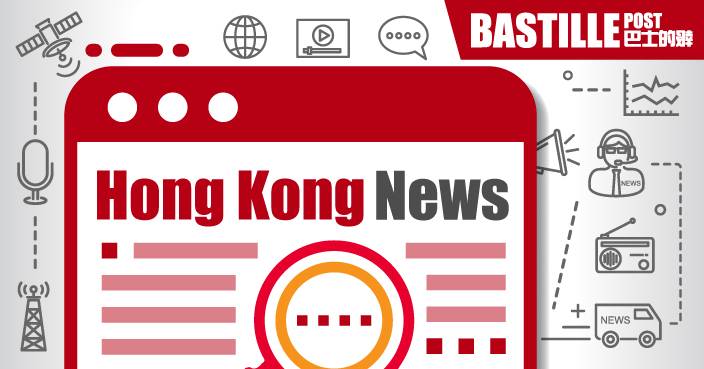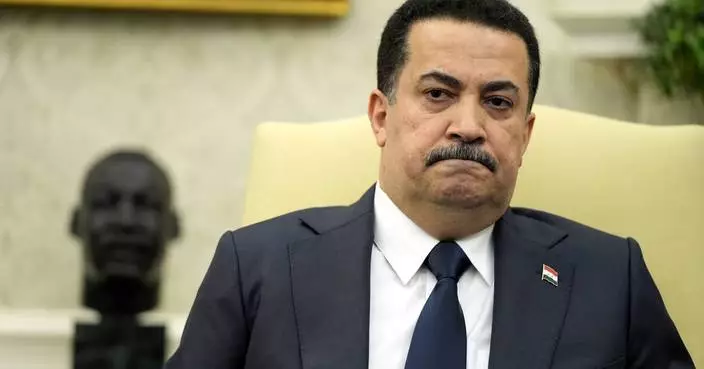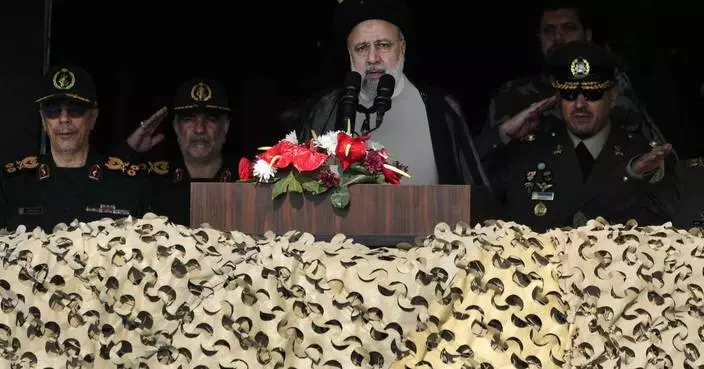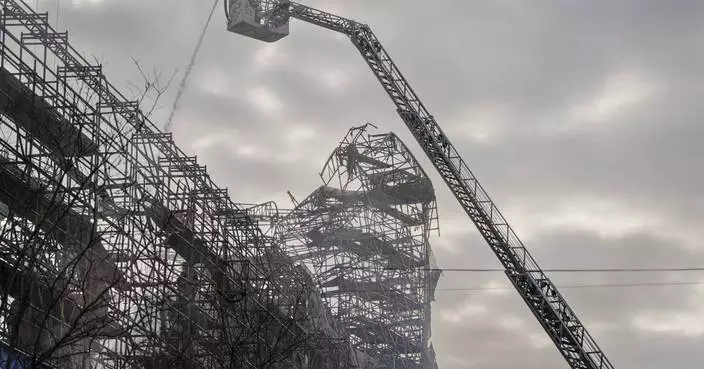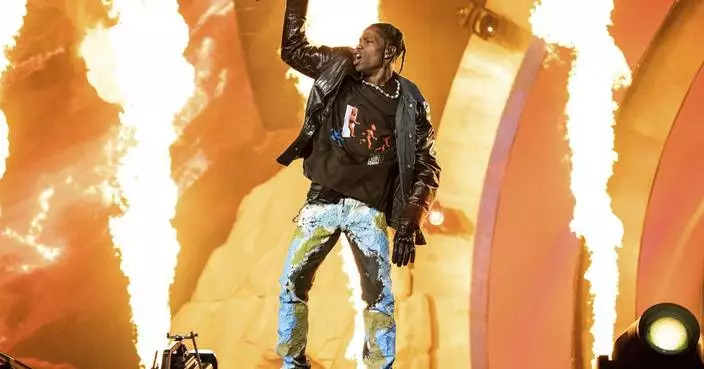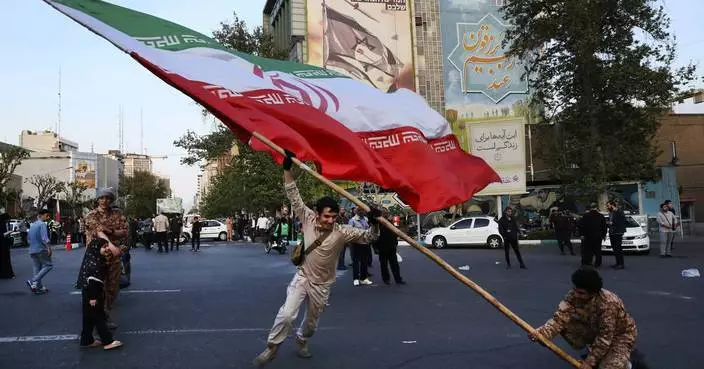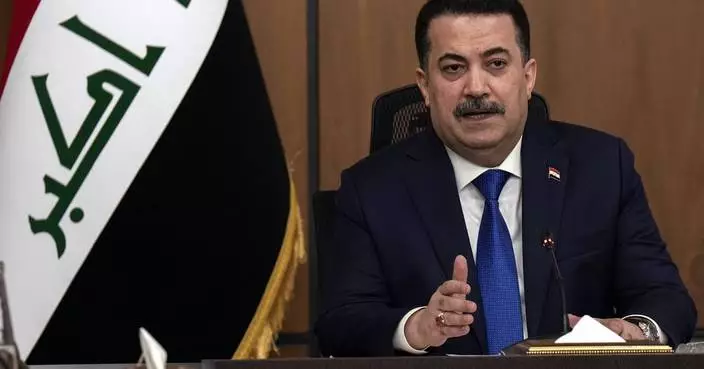The rival Koreas agreed Wednesday to form their first unified Olympic team and have their athletes parade together for the first time in 11 years during the opening ceremony of next month's Winter Olympics in South Korea, officials said.
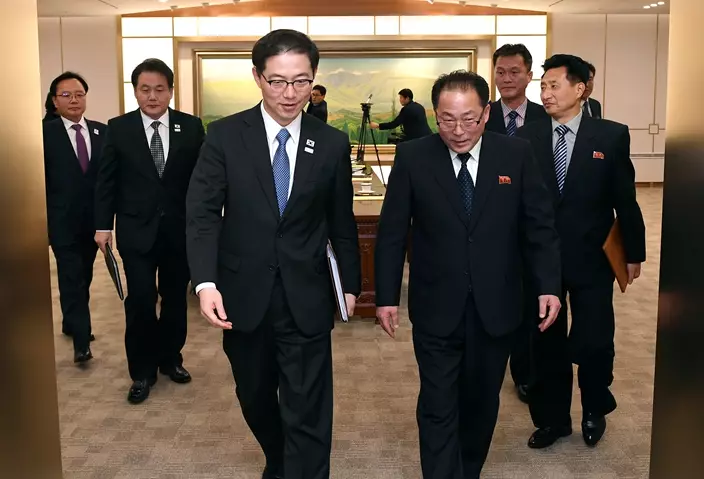
In this photo provided by South Korea Unification Ministry, South Korean Vice Unification Minister Chun Hae-sung, center left, and the head of North Korean delegation Jon Jong Su leave after a meeting at Panmunjom in the Demilitarized Zone in Paju, South Korea, Wednesday, Jan. 17, 2018. (South Korea Unification Ministry via AP)
The agreements still require approval from the International Olympic Committee. But they are the most prominent steps toward rapprochement achieved by the Koreas since they recently began exploring cooperation during the Olympics following a year of heightened tension over the North's nuclear weapons program.
Click to Gallery
The rival Koreas agreed Wednesday to form their first unified Olympic team and have their athletes parade together for the first time in 11 years during the opening ceremony of next month's Winter Olympics in South Korea, officials said.
The agreements still require approval from the International Olympic Committee. But they are the most prominent steps toward rapprochement achieved by the Koreas since they recently began exploring cooperation during the Olympics following a year of heightened tension over the North's nuclear weapons program.
Ahead of the Olympics, the Koreas will hold a joint cultural event at the North's scenic Diamond Mountain and have non-Olympic skiers train together at the North's Masik ski resort, according to the statement. It said the North also plans to send a 150-strong delegation to the Paralympics in March. The North earlier said it would send a 140-member art troupe.
The IOC said in statement Wednesday that it has "taken note of a number of interesting proposals from different sources."
The moves nevertheless have provided a temporary thaw in the Koreas' long-strained ties and fostered optimism that North Korea won't launch any new provocations, at least during the Olympics. Last year, North Korea carried out its sixth and biggest nuclear test explosion and test-fired three intercontinental ballistic missiles, and Kim and U.S. President Donald Trump traded threats of war and crude insults against each other.
Some conservative critics say North Korea's cheering and artistic groups are too big and worry the North may try to steal the show at the Olympics to launch what they call a "peace offensive" to try to show it's a normal country despite pursuing nuclear weapons.
When traveling abroad, however, North Korean athletes and coaches tend to cloister themselves away from outsiders when they are not competing or practicing. Defections are likely a concern, along with what their minders might deem to be ideological "contamination," so they are kept under close scrutiny.
Chief South Korean delegate Chun Hae-sung said the government is well aware of such concerns and North Korea has agreed that the South Korean team's current coach will be given full authority to select North Korean players to compete.
During their third day of talks at the border in about a week, senior officials reached a package of agreements, including fielding a joint women's ice hockey team and marching together under a blue and white "unification flag" depicting their peninsula in the opening ceremony, Seoul's Unification Ministry said.
A joint statement distributed by the ministry said the North Korean Olympic delegation will travel to South Korea across their heavily fortified land border before the Feb. 9-25 Pyeongchang Games. It said the delegation will include a 230-member cheering group, a 30-member taekwondo demonstration team, journalists, athletes and officials.
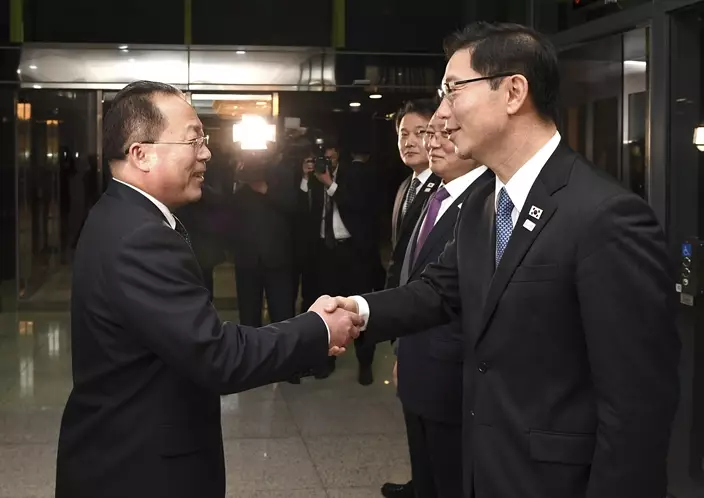
In this photo provided by South Korea Unification Ministry, South Korean Vice Unification Minister Chun Hae-sung, right, shakes hands with the head of North Korean delegation Jon Jong Su after a meeting at Panmunjom in the Demilitarized Zone in Paju, South Korea, Wednesday, Jan. 17, 2018. (South Korea Unification Ministry via AP)
Ahead of the Olympics, the Koreas will hold a joint cultural event at the North's scenic Diamond Mountain and have non-Olympic skiers train together at the North's Masik ski resort, according to the statement. It said the North also plans to send a 150-strong delegation to the Paralympics in March. The North earlier said it would send a 140-member art troupe.
The agreements are highly symbolic and emotional. But it's still not clear how many North Korean athletes will come to Pyeongchang because none are currently qualified. South Korean media have predicted only up to 10 North Korean athletes will end up being covered by an additional quota from the IOC.
A pair of North Korean figure skaters qualified for this year's Olympics, but the country missed a deadline to confirm their participation. The IOC said recently it has "kept the door open" for North Korea to take part in the games. IOC officials are to meet with sports and government officials from the two Koreas and officials from the Pyeongchang organizing committee in Switzerland on Saturday.
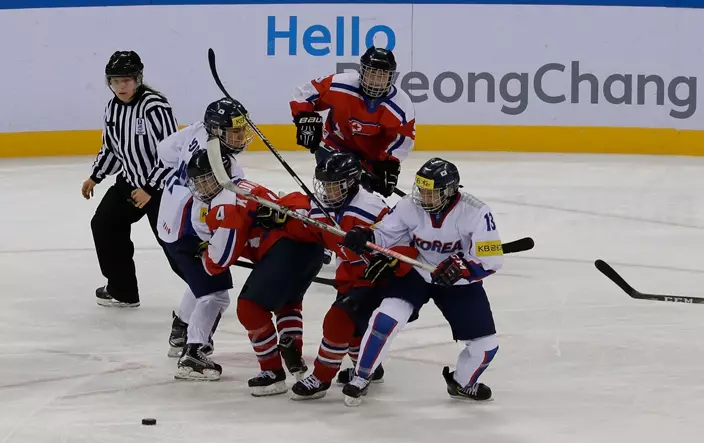
FILE - In this April 6, 2017 file photo, South, wearing white uniforms, and North Korean players compete during their IIHF Ice Hockey Women's World Championship Division II Group A game in Gangneung, South Korea. During South and North Korea's talks at the border in about a week Wednesday, Jan. 17, 2018. (AP Photo/Ahn Young-joon)
The IOC said in statement Wednesday that it has "taken note of a number of interesting proposals from different sources."
"There are many considerations with regard to the impact of these proposals on the other participating NOCs (national Olympic committees) and athletes. After having taken all this into consideration, the IOC will take its final decisions on Saturday in Lausanne," it said.
The two Koreas have sent joint teams to major international sports events twice previously, both in 1991. One event was the world table tennis championships in Chiba, Japan, where the women's team won the championship by beating the powerful Chinese, and the other was soccer's World Youth Championship in Portugal, where the Korean team reached the quarterfinals.
During an era of detente in the 2000s, their athletes marched together in the opening and closing ceremonies of nine international sporting events, including the 2000 Sydney Olympics, but they failed to produce a joint team. Their last joint march was at the Asian Winter Games in Changchun, China, in 2007.
The current reconciliation mood began after North Korean leader Kim Jong Un said in a New Year's speech that he was willing to send a delegation to the games. Critics have said Kim's overture is an attempt to use improved ties with South Korea to weaken U.S.-led international sanctions on North Korea while buying time to perfect his nuclear weapons program.

FILE - In this April 6, 2017 file photo, South, wearing white uniforms, and North Korean players compete during their IIHF Ice Hockey Women's World Championship Division II Group A game in Gangneung, South Korea. During South and North Korea's talks at the border in about a week Wednesday, Jan. 17, 2018. (AP Photo/Ahn Young-joon)
The moves nevertheless have provided a temporary thaw in the Koreas' long-strained ties and fostered optimism that North Korea won't launch any new provocations, at least during the Olympics. Last year, North Korea carried out its sixth and biggest nuclear test explosion and test-fired three intercontinental ballistic missiles, and Kim and U.S. President Donald Trump traded threats of war and crude insults against each other.
The White House says the joint Olympic team is an opportunity for North Korea to see the value of ending its international isolation by getting rid of its nuclear weapons.
"We hope that this experience gives North Korea and its athletes a small taste of freedom, and that rubs off and it's something that spreads and impacts in these negotiations and in these conversations," spokeswoman Sarah Huckabee Sanders said.
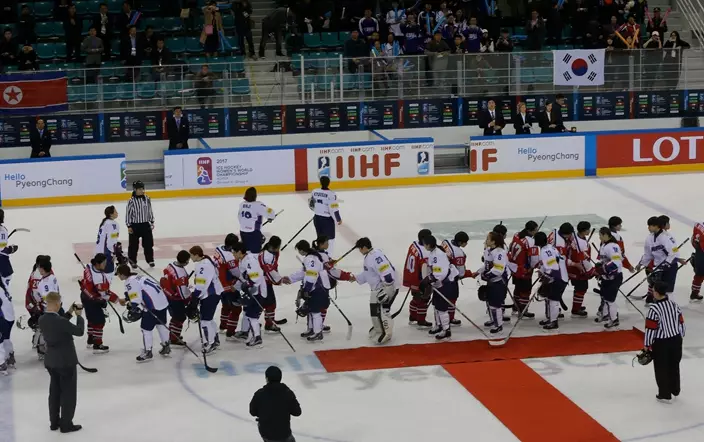
FILE - In this April 6, 2017 file photo, South, wearing white uniforms, and North Korean players shake hands after their IIHF Ice Hockey Women's World Championship Division II Group A game in Gangneung, South Korea. During South and North Korea's talks at the border in about a week Wednesday, Jan. 17, 2018. (AP Photo/Ahn Young-joon)
Some conservative critics say North Korea's cheering and artistic groups are too big and worry the North may try to steal the show at the Olympics to launch what they call a "peace offensive" to try to show it's a normal country despite pursuing nuclear weapons.
North Korea also sent highly trained female cheering groups dressed in bright, attractive outfits when it attended previous international sports events in South Korea. The groups, chosen for their cheering skills as well as their good looks and dubbed "beauty squads" by South Korean media, often received more attention than their athletes. Kim Jong Un's wife, Ri Sol Ju, was a member of a 2005 squad.
North Korea under Kim has made sports, and especially success in international sporting events, a high priority. While it's not a major winter sports competitor, North Korean athletes have set several weightlifting world records and its women hold a high profile on the world football scene.
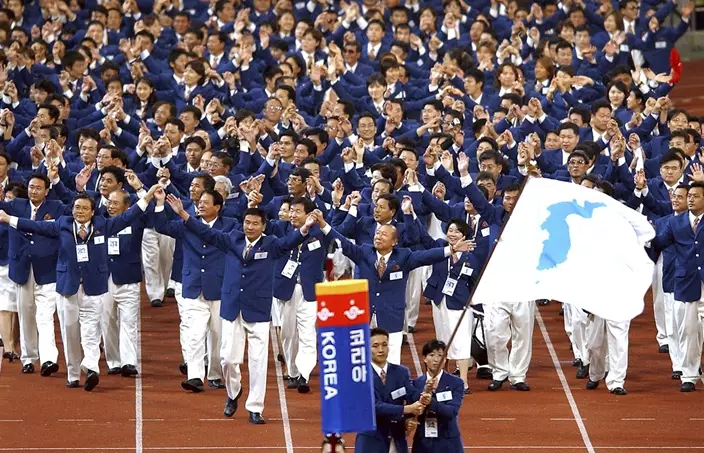
FILE - In this Sept. 29, 2002 file photo, athletes from North and South Korea march together, led by a unification flag, during an opening ceremony for the 14th Asian Games in Busan, South Korea.(Yonhap via AP, File)
When traveling abroad, however, North Korean athletes and coaches tend to cloister themselves away from outsiders when they are not competing or practicing. Defections are likely a concern, along with what their minders might deem to be ideological "contamination," so they are kept under close scrutiny.
South Korea wants to the IOC to allow its ice hockey team's 23-player Olympic roster to be expanded so that several North Korean players can be added without removing any of the South Korean players. But there are worries in South Korea that adding new players less than a month before the Olympics will weaken the team and deprive South Korean players of playing time.

South Korean President Moon Jae-in, left, poses while meeting with South Korean national short track skaters during a visit to Jincheon National Training Center in Jincheon, South Korea, Wednesday, Jan. 17, 2018. (Ha Sa-hun/Yonhap via AP)
Chief South Korean delegate Chun Hae-sung said the government is well aware of such concerns and North Korea has agreed that the South Korean team's current coach will be given full authority to select North Korean players to compete.
"If South and North Korea form one team and compete in the games, that will be an everlasting historic event, which I think will move our people and people around the world," South Korean President Moon Jae-in said Wednesday.
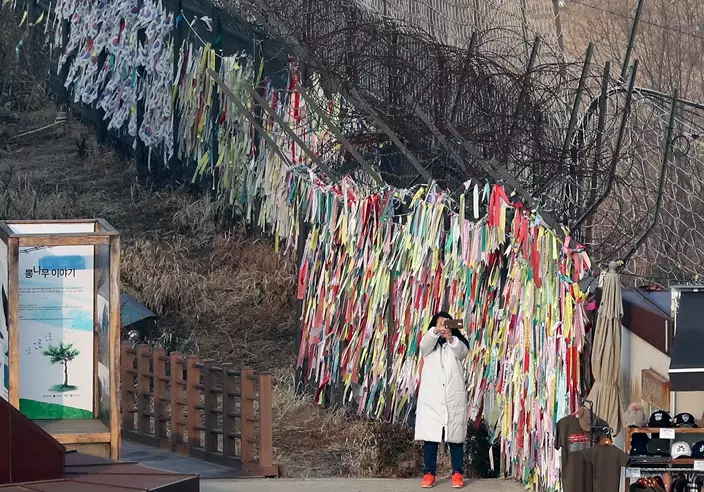
A visitor takes a selfie near the wire fence decorated with ribbons carrying messages to wish for the reunification of the two Koreas at the Imjingak Pavilion in Paju, South Korea, Wednesday, Jan. 17, 2018. (AP Photo/Lee Jin-man)
JERUSALEM (AP) — Israel and Iran on Friday both played down an apparent Israeli airstrike near a major air base and nuclear site in central Iran, signaling the two bitter enemies are ready to prevent their latest eruption of violence from escalating into a full-blown regional war.
But the indecisive outcome of weeks of tensions — which included an alleged Israeli strike that killed two Iranian generals, an unprecedented Iranian missile barrage on Israel and the apparent Israeli strike early Friday in the heart of Iran — did little to resolve the deeper grievances between the foes and left the door open to further fighting.
“It appears we’re closer than ever to a broad regional war, despite the fact that the international community will most likely make a great effort to de-escalate tensions,” wrote Amos Harel, the military-affairs commentator for the Israeli daily Haaretz.
Israel has long considered Iran to be its greatest enemy — citing the Islamic Republic’s calls for Israel’s destruction, its controversial nuclear program and its support for hostile proxies across the Middle East.
These tensions have risen since Hamas and Islamic Jihad, Iranian-backed Palestinian groups, attacked Israel on Oct. 7, sparking a devastating Israeli offensive in Gaza that has continued for more than six months. Hezbollah, an Iranian-backed proxy in Lebanon, immediately began striking Israeli targets, opening up tit-for-tat fighting along a second front, while Iranian-backed militias in Iraq, Syria and Yemen have also fired missiles and drones at Israel throughout the war.
While Israel and Iran have waged a shadow war for years, mostly in neighboring Syria, they have largely avoided direct confrontations. That changed after an April 1 airstrike killed two Iranian generals at an Iranian diplomatic compound in the Syrian capital of Damascus. Although Israel did not comment, Iran blamed Israel for the strike and vowed revenge.
Iran responded with its first-ever direct attack on Israel, launching over 300 missiles and attack drones late Saturday night. Israel, working with a U.S.-led international coalition, said it intercepted 99% of the incoming fire, though a handful of missiles managed to land, causing minor damage to an Israeli military base and seriously wounding a young girl.
In Friday’s attack, Iranian state television said that air defense batteries fired in several provinces over reports of drones in the air. Iranian army commander Gen. Abdolrahim Mousavi said crews targeted several flying objects.
“The explosion this morning in the sky of Isfahan was related to the shooting of air defense systems at a suspicious object that did not cause any damage,” Mousavi said.
Authorities said air defenses fired at a major air base near Isfahan, which long has been home to Iran’s fleet of American-made F-14 Tomcats — purchased before the 1979 Islamic Revolution.
Isfahan also is home to sites associated with Iran’s nuclear program, including its underground Natanz enrichment site, which has been repeatedly targeted by suspected Israeli sabotage attacks. The apparent attack Friday came on Iranian Supreme Leader Ayatollah Ali Khamenei’s 85th birthday.
State television described all Iranian atomic sites in the areas as “fully safe.” The United Nations’ nuclear watchdog, the International Atomic Energy Agency, also said there was “no damage” to Iran’s nuclear sites.
Iranian officials made no mention of possible Israeli involvement. That could be intentional, particularly after Iranian officials for days have been threatening to respond to any Israeli retaliatory attack.
Israel also had no comment on the apparent attack, though one hard-line government minister, Itamar Ben-Gvir, hinted at his dissatisfaction, with a one-word tweet early Friday, using a slang word for weak or lame.
But Italy’s foreign minister, Antonio Tajani, said at a summit of Western leaders in Capri that the U.S. received “last-minute” information from Israel about the attack. U.S. Secretary of State Antony Blinken did not dispute that, but said: “We were not involved in any offensive operations.”
Yoel Guzansky, a former Iran expert in the Israeli prime minister’s office, said Israel appears to have carried out the attack to “check off a box” by sending a message to Iran without doing anything too provocative that could upset the United States, which had urged restraint, or spark further Iranian retaliation.
“It seems very limited, to send a message that ‘we can strike you inside of Iran,’” said Guzansky a senior researcher at the Institute for National Security Studies, a Tel Aviv think tank.
He said “the current round” of violence appears to be over, but that “nothing has changed” with Israel still facing Iranian-backed threats on various fronts.
“I see further rounds,” he said. And the next time, if Iran surprises Israel or allies don’t assist in Israel’s defense, “the outcome will be different.”
U.N. Secretary-General Antonio Guterres called for an end to the strikes.
“It is high time to stop the dangerous cycle of retaliation in the Middle East,” his office said.
Charles Lister, a senior fellow at the Washington-based Middle East Institute and a longtime regional analyst, challenged Iran’s claims that drones carried out the attacks. It appears instead that a small number of Israeli aircraft flew from Israel over Syria — striking at least two southern Syria military bases that have air defense systems along the way, he said.
They then entered Iraqi airspace, from where they fired a small number of Blue Sparrow air-to-surface ballistic missiles, likely without ever entering Iranian airspace, Lister said.
Accounts of explosions over Iraq support that scenario, and so does debris from what appears to be the booster of an Israeli-made Blue Sparrow missile that Iraqi security found in a field outside Baghdad, Lister said.
“In other words, the Israelis would never have needed to enter Iranian airspace to conduct this attack,” Lister said. "I think this was Israel’s way of just sending a message that we can reach you anywhere we want.”
If this latest round subsides, Israel can now return its focus to its ongoing war in Gaza and the simmering fighting with Hezbollah. With neither of those fronts letting up, the risk of further run-ins with Iran remains high, though neither side appears eager after Friday's apparent Israeli attack.
“Neither side is ready to jump over the brink," said Alex Vatanka, director of the Iran program at the Middle East Institute. But he added a major caveat.
“Probably we’re going to go back to the proxy war, “ he said, but now it’s a proxy war with the risk of “that sudden eruption of state-to-state war. Which we didn’t have to worry about before.”
Gambrell reported from Dubai, United Arab Emirates. Associated Press journalists Nasser Karimi, Mehdi Fattahi and Amir Vahdat in Tehran, Iran; Bassem Mroue in Beirut; Ellen Knickmeyer in Washington; Qassim Abdul-Zahra in Baghdad; and Nicole Winfield in Capri, Italy; contributed to this report.
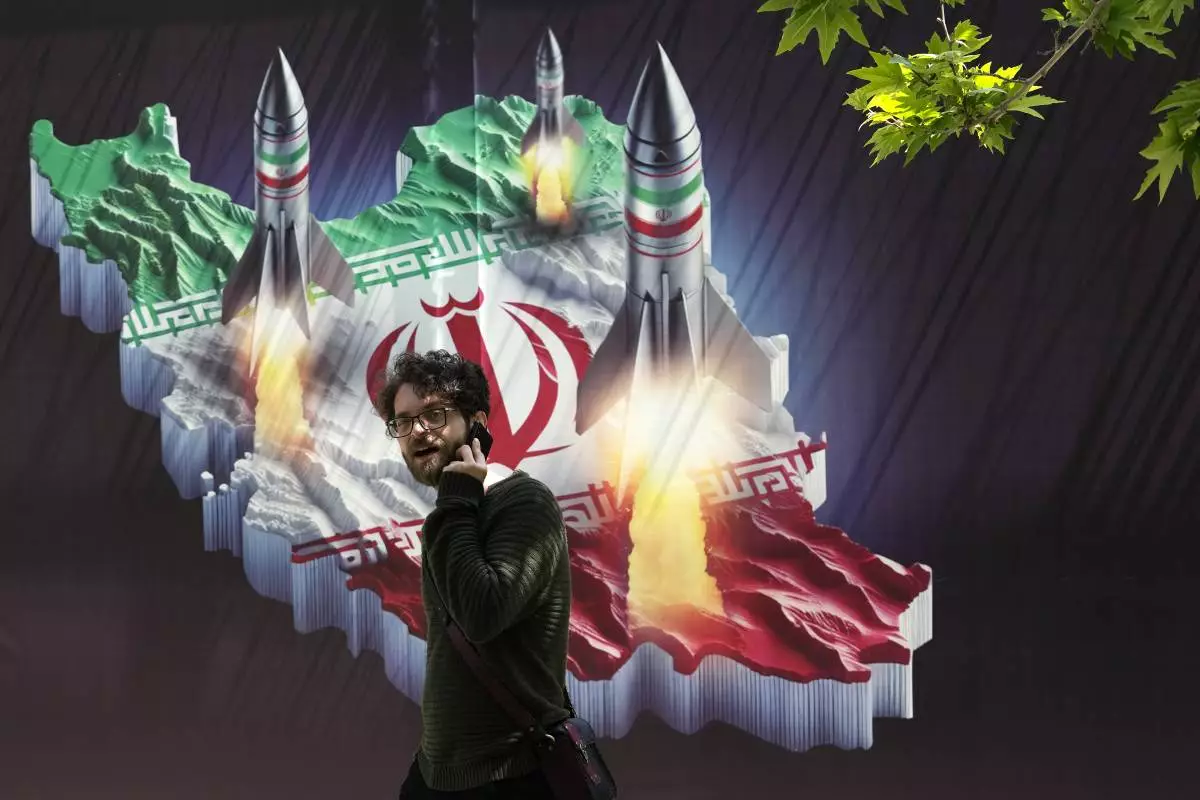
A passerby, taking on his cellphone, walks past a banner showing missiles being launched from Iranian map in northern Tehran, Iran, Friday, April 19, 2024. Iran fired air defenses at a major air base and a nuclear site near the central city of Isfahan after spotting drones early Friday morning, raising fears of a possible Israeli strike in retaliation for Tehran's unprecedented drone-and-missile assault on the country. (AP Photo/Vahid Salemi)
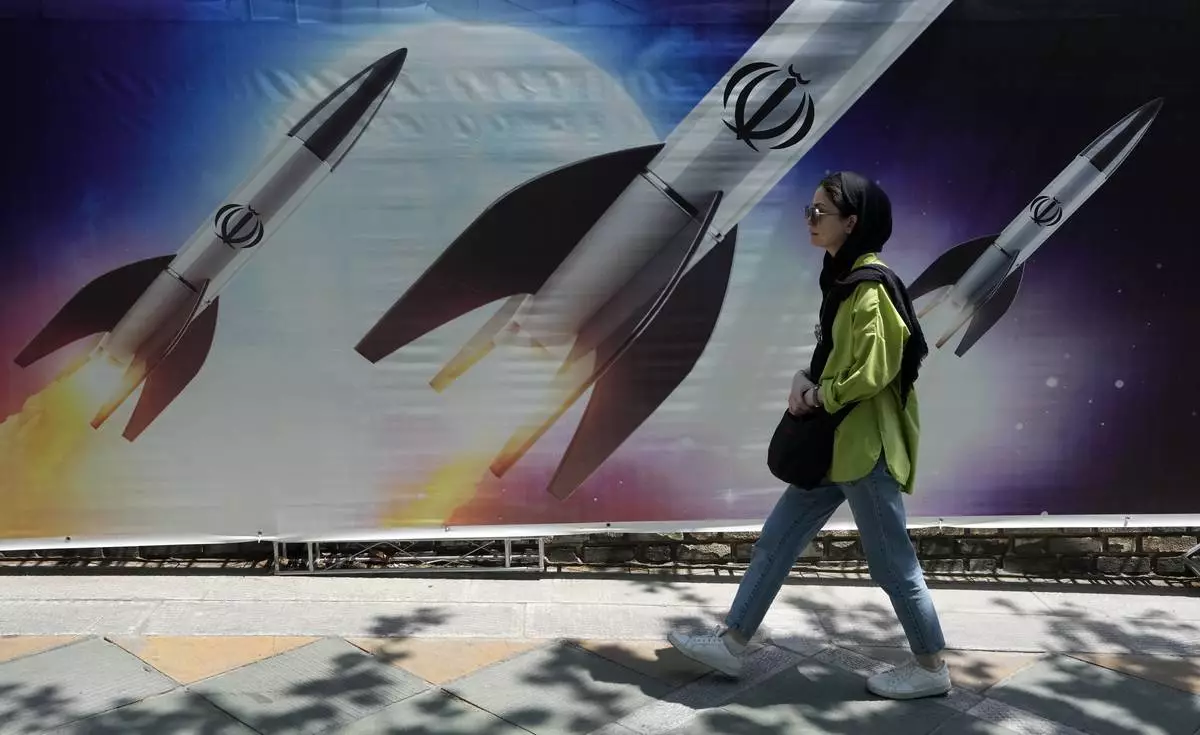
A woman walks past a banner showing missiles being launched, in northern Tehran, Iran, Friday, April 19, 2024. Iran fired air defenses at a major air base and a nuclear site near the central city of Isfahan after spotting drones early Friday morning, raising fears of a possible Israeli strike in retaliation for Tehran's unprecedented drone-and-missile assault on the country. On the missiles, a decorative sign reads: "Allah" (AP Photo/Vahid Salemi)
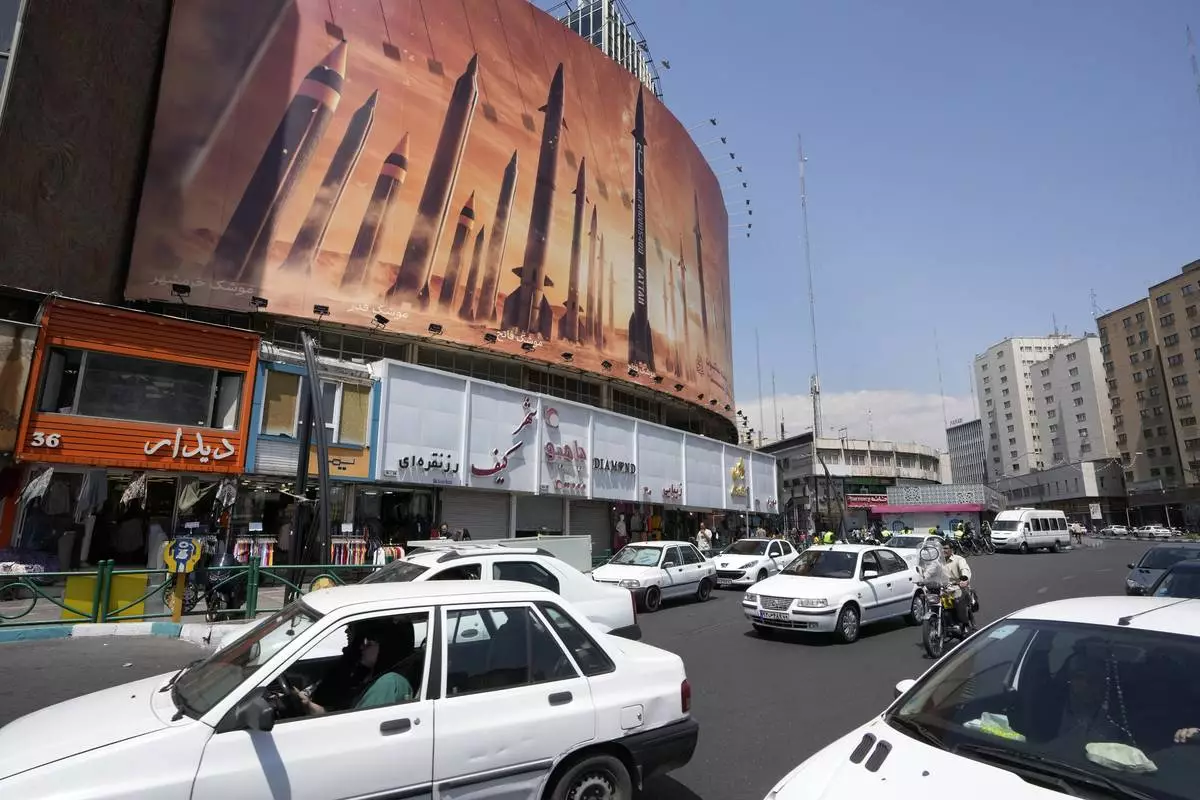
Vehicles drive past an anti-Israeli banner showing missiles being launched, in a square in downtown Tehran, Iran, Friday, April 19, 2024. Iran fired air defenses at a major air base and a nuclear site near the central city of Isfahan after spotting drones early Friday morning, raising fears of a possible Israeli strike in retaliation for Tehran's unprecedented drone-and-missile assault on the country. (AP Photo/Vahid Salemi)
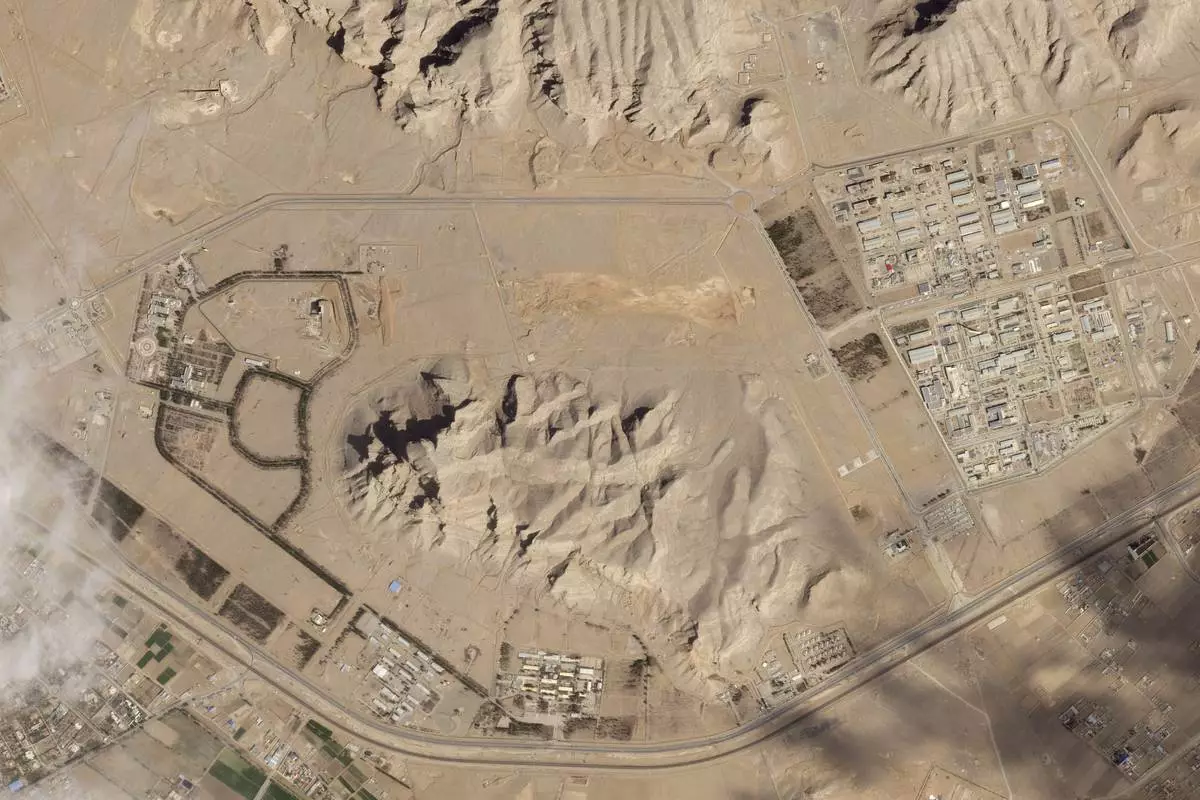
This satellite image from Planet Labs PBC shows Iran's nuclear site in Isfahan, Iran, April 4, 2024. Iran fired air defenses at a major air base and a nuclear site early Friday morning near the central city of Isfahan after spotting drones, which were suspected to be part of an Israeli attack in retaliation for Tehran's unprecedented drone-and-missile assault on the country. (Planet Labs PBC via AP)
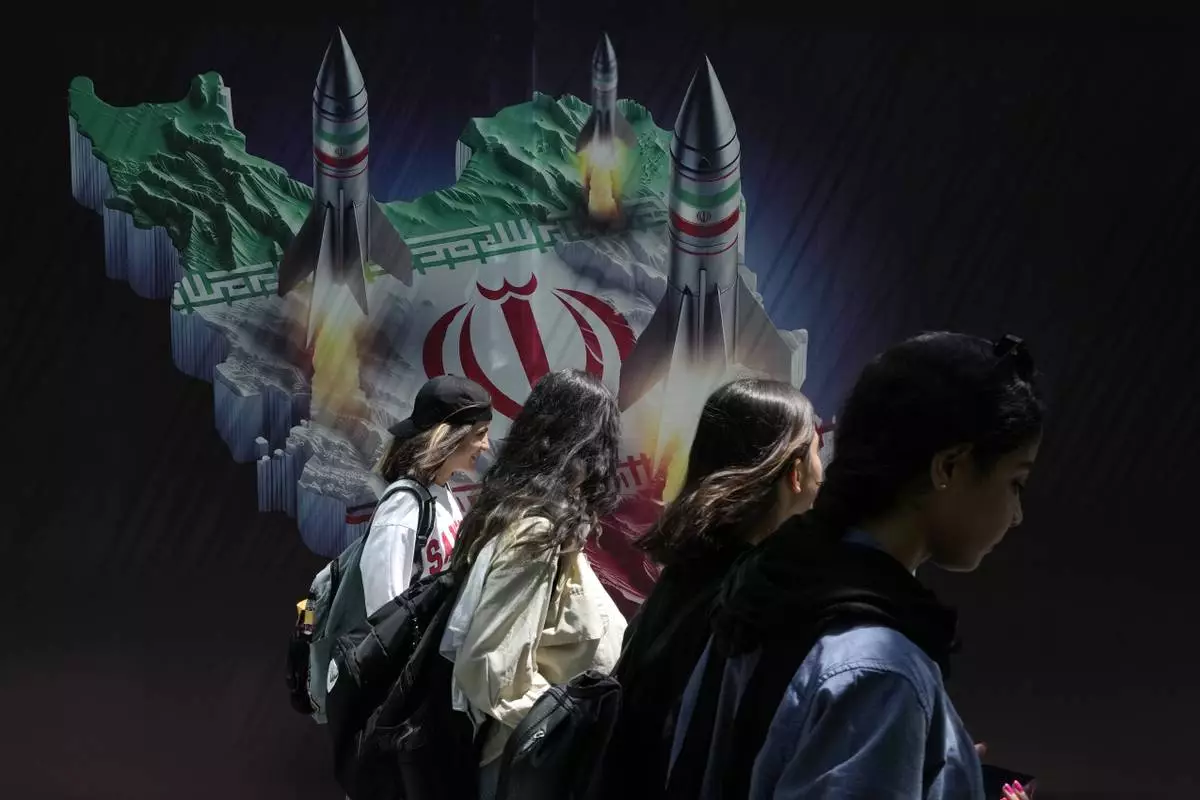
Iranian women without wearing their mandatory Islamic headscarf walk past a banner showing missiles being launched from Iranian map in northern Tehran, Iran, Friday, April 19, 2024. Iran fired air defenses at a major air base and a nuclear site near the central city of Isfahan after spotting drones early Friday morning, raising fears of a possible Israeli strike in retaliation for Tehran's unprecedented drone-and-missile assault on the country. (AP Photo/Vahid Salemi)










